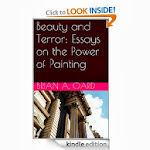Let us consider the cinematic leitmotif in Kawabata's Snow Country. (And then let us ignore all blog posts that begin with an archaic-pompous 'let us' instead of the demotic, Dude-like 'let's.') The most immediately impressive thing about this novella is Kawabata's linguistic landscape painting. This is an intensely visual work, deliberately cinematic. It reads like a lyrical prose description of a Fifties or Sixties Japanese art film by Kurosawa, Teshigahara or Oshima. And from first scene to last, a pattern of explicitly cinematic imagery runs through the novel. The first scene's filmic superimposition of Yoko's reflection upon the passing landscape establishes a leitmotif in which Shimamura is repeatedly positioned as a viewer/voyeur who is pierced by images reflected in mirrors or framed by windows or--as in his devotion to occidental dance--printed in books. At the novel's climax, a makeshift cinema in a warehouse burns to the ground after the film literally catches fire in the projector. The carefully constructed motif seems to self-destruct by spontaneous combustion. All the various screens that have enabled Shimamura's voyeuristic life are thus symbolically incinerated, and his consciousness is opened to a transcendental vision of the Milky Way. That's one way, I suppose, to interpret the novel's conclusion, but I find this interpretation unsatisfactory. My most serious objection is to the jarringly abrupt, seemingly arbitrary appearance of the Milky Way as a kind of astronomical deus ex machina bringing the action to a supposedly sublime and satisfying close. I think we should interpret this transcendental conclusion much more sceptically. The sublime night sky is better interpreted as the novel's final, culminating screen. It is a movie screen infinitely larger than the world, and it functions, like the train window in the first scene and the never-seen, already incinerated movie screen in the last, to screen its viewer(s) from the mundane messiness and absurd tragedies of life. Kawabata deliberately and subtly sets the first and final scenes in parallel by describing the light that seems to emanate from Yoko's reflected eye in the first scene as a "distant, cold light." It is akin to the light of an evening star--and to the light of the multitude of stars in the final scene's Milky Way. The novel's climactic tragedy necessitates its largest screen. The transcendental leap in the final pages is not a religious-humanistic act of acceptance but yet another image of flight, an escape into the supernatural that protects Shimamura from the full impact of the tragedy he witnesses. The burning of the cinema throws Shimamura back upon a natural Romanticism that is every bit as escapist as the movies. And so the novel ends with him still running, still fleeing an inescapable life.
(A probably unnecessary disclaimer: This interpretation, like all interpretations of great art, is highly arguable and partial. It is presented not as the final word on Snow Country but as one more word, one more hopefully interesting, and possibly provocative, thought.)
Wednesday, November 10, 2010
Subscribe to:
Post Comments (Atom)










No comments:
Post a Comment